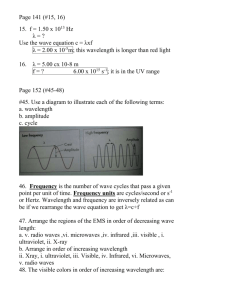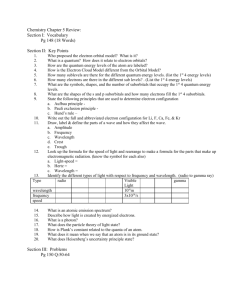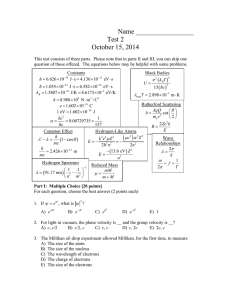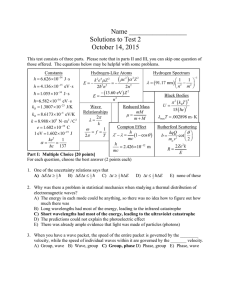Name _________________ Test 2 October 14, 2015
advertisement
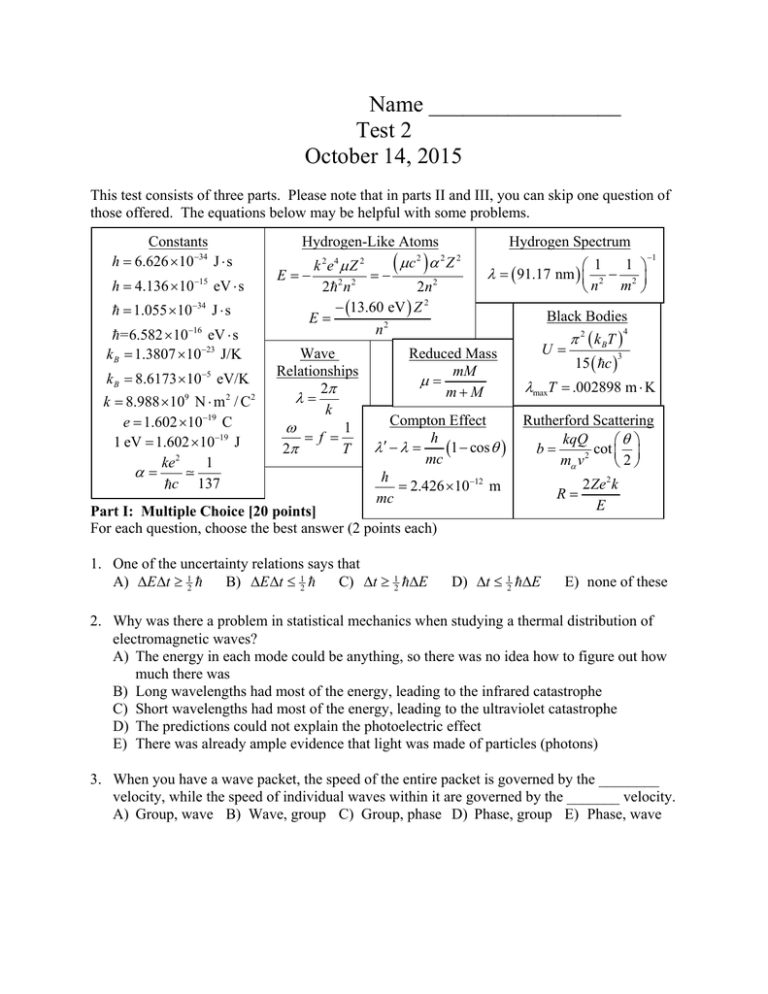
Name _________________ Test 2 October 14, 2015 This test consists of three parts. Please note that in parts II and III, you can skip one question of those offered. The equations below may be helpful with some problems. Constants h 6.626 1034 J s h 4.136 1015 eV s 1.055 1034 J s 16 =6.582 10 eV s k B 1.3807 1023 J/K k B 8.6173 105 eV/K k 8.988 109 N m 2 / C2 e 1.602 1019 C 1 eV 1.602 1019 J ke 2 1 c 137 Hydrogen-Like Atoms c2 2 Z 2 k 2e4 Z 2 E 2 2 n 2 2n 2 13.60 eV Z 2 E n2 Wave Relationships 2 k 1 f 2 T Hydrogen Spectrum 1 1 91.17 nm 2 2 n m Reduced Mass mM mM Compton Effect h 1 cos mc h 2.426 1012 m mc Black Bodies U 2 k BT 15 c 4 3 maxT .002898 m K Rutherford Scattering kqQ cot b 2 m v 2 Part I: Multiple Choice [20 points] For each question, choose the best answer (2 points each) 1. One of the uncertainty relations says that A) E t 12 B) E t 12 C) t 12 E 1 D) t 12 E R 2Ze 2 k E E) none of these 2. Why was there a problem in statistical mechanics when studying a thermal distribution of electromagnetic waves? A) The energy in each mode could be anything, so there was no idea how to figure out how much there was B) Long wavelengths had most of the energy, leading to the infrared catastrophe C) Short wavelengths had most of the energy, leading to the ultraviolet catastrophe D) The predictions could not explain the photoelectric effect E) There was already ample evidence that light was made of particles (photons) 3. When you have a wave packet, the speed of the entire packet is governed by the ________ velocity, while the speed of individual waves within it are governed by the _______ velocity. A) Group, wave B) Wave, group C) Group, phase D) Phase, group E) Phase, wave 4. Which hypothesis is attributed to deBroglie? A) Electrons have wave-like properties B) Electrons must satisfy Schrödinger’s equation C) Electrons orbit the nucleus on circular paths D) Electrons have angular momentum that is a multiple of E) Electrons satisfy an uncertainty relation on their position and momentum 5. If 4 3i , what is ? 2 A) 7 B) 25 C) 7 + 24i D) 25 + 24i E) None of these 6. If f x, y A x 2 y 2 , then f x A) Ax B) 2Ax C) A(x + y) D) 2A(x + y) E) 2Ay 7. In which of the following ways is an atom very much like the solar system? A) The main force involved is electromagnetism in both cases B) The main force involved is gravity in both cases C) The force between two of the orbiting objects is negligible compared to the force between one of the orbiting objects and the central object D) The angular momentum for a single electron or planet is usually a small multiple of E) The central object (Sun or nucleus) is much smaller than the size of the whole object (solar system or atom) 8. A dispersion relation is a relation between which two quantities? B) and f C) and T D) and k A) and k E) f and T 9. Rutherford scattered alpha particles off of gold atoms, and discovered, to his surprise, that A) Most of them went straight through, suggesting the atom was mostly empty space B) The gold atoms were often knocked out, suggesting they were loosely bound C) The electrons did little to stop them, showing that electrons were light D) The alpha particles sometimes scattered at large angles, suggesting there was a lot of mass and charge concentrated in the “nucleus” E) The gold atoms would often be transmuted to other metals, like lead 10. Wave effects in quantum mechanics are not noticeable in the everyday world because A) Quantum mechanics doesn’t apply to composite objects, like all everyday objects B) Quantum effects only describe wave packets, which don’t apply to particles C) Quantum effects are so slow that you can’t observe them D) The wavelength is enormous compared to the size of everyday objects E) The wavelength is tiny compared to the size of everyday objects Part II: Short answer [20 points] Choose two of the following questions and give a short answer (2-3 sentences) (10 points each). 11. Explain, in the photoelectric effect, why there is a minimum frequency which suffices to free an electron from a metal. When you are above that frequency, give a formula for the maximum energy with which an electron can be ejected. 12. Since an electron is attracted to the nucleus, it should have a minimum energy when it is exactly at the nucleus and has zero velocity. Explain why this can’t happen in quantum mechanics. You should have at least one mathematical relation in your answer. 13. When electrons are accelerated through a thin gas, and the voltage is gradually increased, at first the current will increase, then at certain threshold velocities, the current will suddenly drop and the gas begins to glow. Explain qualitatively what is happening. Part III: Calculation: [60 points] Choose three of the following four questions and perform the indicated calculations (20 points each). 14. One important event in the early universe is called recombination, and occurred when the temperature of the universe was approximately T = 2970 K. The universe was filled with almost perfect black body radiation at this time. (a) Find the energy density of the blackbody radiation at this time in J/m3. (b) Find the wavelength where the blackbody radiation was strongest at this time, in nm. (c) Find the energy for a single photon corresponding to the wavelength you found in part (b). (d) Using the energy density you found in part (a) and the energy you found in part (c), estimate the number of photons per unit volume (in m-3) at this time. 15. A N+6 ion has atomic number Z = 7, one electron, and is in the n = 7 state initially. (a) What is the energy of this state? (b) A photon of energy E = 13.056 eV is absorbed by this atom. What is the new energy of the atom? What is the value of n now? (c) The same atom, still at n = 7, instead emits a photon of energy E = 13.056 eV. What is the new energy of the atom? What is the value of n now? (d) What is the wavelength of light corresponding to an energy of E = 13.056 eV? 16. The 2015 Nobel Prize in physics went to experimenters who demonstrated that one of the neutrinos has mass. Based on the measured mass, a long wavelength neutrino would have a dispersion relation of the form Ak 2 where A 6650 m 2 /s . (a) Find a formula for the phase velocity and the group velocity in terms of k. (b) A typical neutrino left over from the Big Bang might have k 851 m 1 . For this wave, find the wavelength , the angular frequency and the frequency f. (c) Find the group and phase velocity for the neutrino from part (b) in m/s. (d) Find the energy in eV of the neutrino you found in part (b). 17. The wave function for a particle is given by Nx 2a x a , elsewhere. 0 x – 2a Na –a (x) a – Na – 2Na x where N and a are positive constants. The wave is sketched at right. (a) Where in the allowed region 2a x a is the particle most likely to be? Where is it impossible for it to be? You can rely on the sketch if you wish. (b) What is the normalization constant N? (c) If the particle’s position is measured, what is the probability that it will have x > 0?



